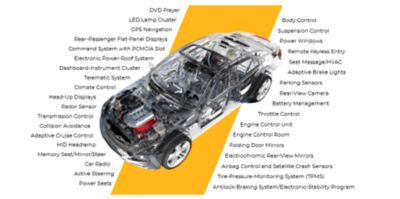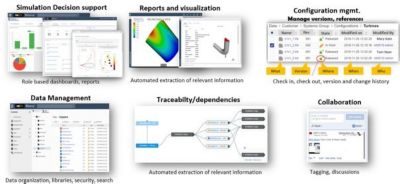-
Ansys is committed to setting today's students up for success, by providing free simulation engineering software to students.
-
Ansys is committed to setting today's students up for success, by providing free simulation engineering software to students.
-
Ansys is committed to setting today's students up for success, by providing free simulation engineering software to students.
-
Contact Us -
Careers -
Students and Academic -
For United States and Canada
+1 844.462.6797
ANSYS BLOG
May 31, 2023
4 Ways to Design More Reliable Automotive Electronics
From engine management systems (fuel injection rate, emissions control, cooling systems) and autonomous controls (lane, speed, park assist, adaptive cruise control) to infotainment systems and comfort systems (climate control, electronic seat adjustment, automatic wipers, etc.), the modern-day gas-powered and electric vehicles have more electronic devices than ever. Indeed, the microprocessors and chips that power modern vehicles are now so prevalent that they’re practically a commodity in the same vein as steel and aluminum.

List of electronics inside an automobile.
According to a Deloitte study,1 electronics are responsible for 40% of a new car’s total cost, with an expectation to grow to 45% within the next few years. Assuring automotive electronics reliability must be top of mind for designers and manufacturers as they deploy new models to the market. Ansys simulation software can help original equipment manufacturers (OEMs) and suppliers design for reliability (DfR) from the start of a project — from integrated circuits (ICs) all the way to printed circuit boards (PCBs) and enclosures.
The Four Categories of Automotive Electronics
Automotive electronics can typically be classified into four different categories.
- Functional electronics (critical to vehicle operation): antilock braking systems (ABS), automatic transmission control, starters, fuel injection, headlights, and electromechanical parking brakes.
- Regulatory compliance electronics (mandated by NHTSA or DOT): airbags, emission controls, back-up camera, and collision detection radar.
- Differentiating electronics (unique, customer-oriented technologies): infotainment, adaptive cruise control, Wi-Fi connectivity, and advanced driver assistance systems (ADAS).
- Growth opportunities (for vehicles in general): collision detection, in-dash displays, heads-up displays (HUD), enhanced infotainment systems, vehicle-to-vehicle communication (V2V), and improved Wi-Fi.
Because of the number and variety of electronics within an automobile’s use environments — including potentially much longer duty cycles for autonomous vehicles — and longer lifetime requirements driven by consumer demands, automotive electronics designers, and manufacturers must consider virtual validation along with physical testing in order to keep costs at a reasonable rate and meet shrinking development timelines.
Testing for Failure
Electronic usage is not new, and other industries such as consumer electronics and high tech have to meet a number of requirements, including:
- Immobility/limited vibration
- Little to no mechanical shock
- Low humidity/controlled temperatures of office environments
- Predictable duty cycles
While those dynamics are ideal for, say, household electronics, the stressors that automotive electronics are exposed to are much more extreme, including:
- Harsh mobile environments
- Large temperature swings
- Sustained periods of vibration — and, in the case of accidents, sudden shock
- Longer lifetimes; a car is expected to last 10 years, unlike a cell phone or laptop
Couple this with ever-shrinking feature sizes, including environment and movement sensors, onboard computer systems and networks, and vehicle control actuators. Suddenly, best performance predictability is on a sliding scale over one, five, or even 10 years of driving, and degradation takes its toll.
Designing More Reliable Automotive Electronics
To design more reliable automotive electronics, there are a number of best practices to consider.
Eliminate Failures During Testing
As much as 73% of product development costs are caught up in a "fix-fail-fix-repeat” cycle. When electronic products are undergoing physical testing, they can go through rounds of design cycles to fix uncovered failure modes. However, this can be costly and time consuming. Virtual prototyping, or simulation, is one of the best ways to test for failures before a product is physically manufactured.
Simulations must, however, include accurate material inputs and the proper loading conditions to ensure simulation results match up as close to physical reality as possible. This reduces design cycles by catching failures early in the design phase, allowing engineers to make design changes before a physical prototype is produced. Simulation does not completely replace physical testing, but it can greatly reduce the number of tests performed.
Reusing Engineering Ideas and Assets
Much of the automotive electronics manufactured can take advantage of model reuse. Once a reliable model is created, it can continue to be reused and optimized for future versions. This is a concept that can also be used in simulation, in which simulation models can be reused and updated based on new reliability and safety requirements.

The Ansys ecosystem for supporting engineers and designers in data management, project tracking, data-driven decision making, and more.
The benefit of using simulation to help aid design is the variety of configuration and data management, visualization, transparency, and collaboration that is provided. All simulation models and results are documented for future use, and automation and optimization workflows can be used to facilitate design decisions.
In addition, having proper data management that is transparent allows different departments (such as electrical and mechanical engineering departments) to work together on a common design and ensure that all cross-departmental reliability goals are being met and data is being passed back and forth efficiently.
Watch our webinar series to learn how you can use Ansys Minerva to manage automotive electronics reliability workflows.
Auditing Suppliers
If you are an original equipment manufacturer (OEM), it’s also exceedingly important to audit your automotive electronic suppliers. Since the start of the pandemic, supply chains have been affected, particularly within the automotive industry. Supply chains have slowed, opening the way for the proliferation of counterfeit or alternate parts. Unfortunately, it is often difficult to tell when a part is counterfeit. It is important to either audit your supplier or perform a robust design review of parts received to ensure they are valid.
Ensuring Manufacturing Is to Specification
There are a number of specs and requirements that automotive electronics must meet before they are included in an overall automotive manufacturing process. Some of those specs include requirements like the recently updated GMW 3172, VW 8000, and the ISO 26262 safety standard. Most of these standards require electronics to function at a reliable level at certain temperatures, vibration levels, moisture levels, and more. There are physical tests that can be performed to ensure electronic parts are meeting these reliability specs, but there are also simulation workflows that can be used to see if an electronic design will meet these requirements before a physical prototype is built. Most of these simulation workflows include multiphysics and involve a number of different software tools. This allows a user to perform the most robust and accurate analysis as possible while considering the effects of electro-thermo-mechanical stress on the electronic parts within a vehicle.
Watch the third webinar in our Automotive Electronics Reliability webinar series to learn about our electro-thermo-mechanical workflows.
References
- “Electronics Account for 40 Percent of the Cost of a New Car.” Car and Driver, May 2, 2020.
See What Ansys Can Do For You
See What Ansys Can Do For You
Contact us today
Thank you for reaching out!
We’re here to answer your questions and look forward to speaking with you. A member of our Ansys sales team will contact you shortly.











